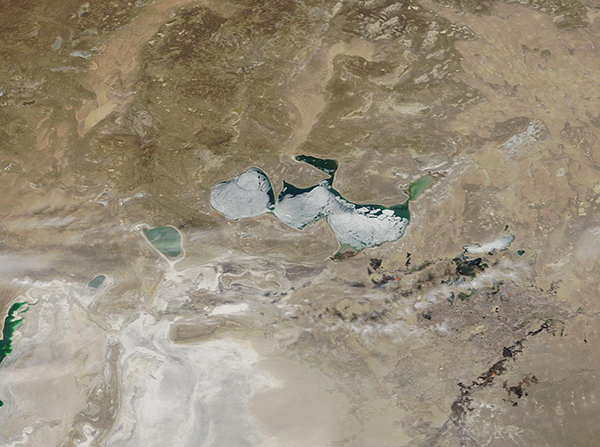Images
March 27, 2023 - Ice receding on the North Aral Sea
Tweet
On March 23, 2023, the Moderate Resolution Imaging Spectroradiometer (MODIS) on board NASA’s Terra satellite acquired a true-color image of a sun-filled early spring day over southern Kazakhstan.
Winters in the region bring sub-zero cold and copious snow, while the dry, hot summers frequently register temperatures over 110˚F (40˚C). By late March, the rapid transition between extremes is well underway. The North Aral Sea provides the most obvious sign of the seasonal change. While most of the lake is covered in ice, the waters near the northern shores are ice-free thanks to rising temperatures and lengthening daylight.
Patches of snow-like white that are scattered across the arid tan land surrounding the North Aral Sea are not snow, but highly-reflective mineral crusts left after the water in the once-large lake evaporated over the last several decades. This is especially noticeable south of the south of the North Aral Sea, in the very recently desiccated seabed of the South Aral Sea. A bit of blue along the southwestern (lower left) edge of the image shows water in the northern tip of the western arm of the South Aral Sea.
Once large and vibrant, the Aral Sea has been shrinking since the 1960s, and in 2007 it separated into three distinct basins. Today, some water remains in the North Aral Sea and in the in the western basin of the South Aral Sea. The desiccated eastern basin of the South Aral Sea is now sometimes referred to as the Aralkum Desert, one of the newest deserts on Earth.
Image Facts
Satellite:
Terra
Date Acquired: 3/23/2023
Resolutions:
1km (145.2 KB), 500m (376.3 KB), 250m (240.7 KB)
Bands Used: 1,4,3
Image Credit:
MODIS Land Rapid Response Team, NASA GSFC
Tweet
On March 23, 2023, the Moderate Resolution Imaging Spectroradiometer (MODIS) on board NASA’s Terra satellite acquired a true-color image of a sun-filled early spring day over southern Kazakhstan.
Winters in the region bring sub-zero cold and copious snow, while the dry, hot summers frequently register temperatures over 110˚F (40˚C). By late March, the rapid transition between extremes is well underway. The North Aral Sea provides the most obvious sign of the seasonal change. While most of the lake is covered in ice, the waters near the northern shores are ice-free thanks to rising temperatures and lengthening daylight.
Patches of snow-like white that are scattered across the arid tan land surrounding the North Aral Sea are not snow, but highly-reflective mineral crusts left after the water in the once-large lake evaporated over the last several decades. This is especially noticeable south of the south of the North Aral Sea, in the very recently desiccated seabed of the South Aral Sea. A bit of blue along the southwestern (lower left) edge of the image shows water in the northern tip of the western arm of the South Aral Sea.
Once large and vibrant, the Aral Sea has been shrinking since the 1960s, and in 2007 it separated into three distinct basins. Today, some water remains in the North Aral Sea and in the in the western basin of the South Aral Sea. The desiccated eastern basin of the South Aral Sea is now sometimes referred to as the Aralkum Desert, one of the newest deserts on Earth.
Image Facts
Satellite:
Terra
Date Acquired: 3/23/2023
Resolutions:
1km (145.2 KB), 500m (376.3 KB), 250m (240.7 KB)
Bands Used: 1,4,3
Image Credit:
MODIS Land Rapid Response Team, NASA GSFC




